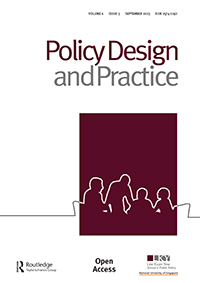The ecology of open innovation units: adhocracy and competing values in public service systems
IF 2.6
Q1 PUBLIC ADMINISTRATION
引用次数: 10
Abstract
Abstract There have been concerted efforts to encourage innovation and to foster a more innovative and “open” culture to government and public service institutions. Policy and service innovation labs constitute one part of a broader “open innovation” movement which also includes open data, behavioral insights, digital services, data science units, visualization capabilities, and agile and lean methods. This article argues that we need to step back and better understand these “ecologies” of innovation capabilities that have emerged across public service institutions, and to recognize that as fellow “innovation” traveling companions they collectively seek to transform the culture of government and public service institutions, producing more effective, efficient and tailored policies and services. This article introduces analytic frameworks that should help locate policy and innovation labs amidst these other innovating entities. First, it delineates the various units and initiatives which can be seen as committed to new ways of working and innovating in public service institutions, often relying on “open innovation” rhetoric and approaches. Second, it shows how – despite the diversity among these entities – they nevertheless share similar attributes as “adhocracies” and are located as part of a broader movement and class of organizations. Third, we locate these diverse OI entities amidst broader public service systems using the Competing Values Framework. Fourth, this article situates the challenges confronting OI units developing and sustaining or broadening niches in public service systems. Finally, it identifies future research questions to take up.开放创新单位的生态:公共服务体系中的专治与竞争价值
摘要政府和公共服务机构一直在共同努力鼓励创新,培养更具创新性和“开放”的文化。政策和服务创新实验室是更广泛的“开放创新”运动的一部分,该运动还包括开放数据、行为洞察、数字服务、数据科学单元、可视化能力以及敏捷和精益方法。本文认为,我们需要退后一步,更好地理解公共服务机构中出现的创新能力的“生态”,并认识到,作为“创新”旅伴,他们共同寻求改变政府和公共服务机构的文化,高效和量身定制的政策和服务。本文介绍了分析框架,这些框架应该有助于在这些其他创新实体中定位政策和创新实验室。首先,它描述了可以被视为致力于公共服务机构新的工作方式和创新的各种单位和举措,通常依赖于“开放创新”的言论和方法。其次,它表明,尽管这些实体之间存在多样性,但它们与“adhochries”具有相似的属性,并作为更广泛的运动和组织阶层的一部分。第三,我们使用竞争价值观框架将这些不同的OI实体定位在更广泛的公共服务系统中。第四,本文阐述了OI单位在发展、维持或扩大公共服务系统中的利基市场所面临的挑战。最后,它确定了未来的研究问题。
本文章由计算机程序翻译,如有差异,请以英文原文为准。
求助全文
约1分钟内获得全文
求助全文
来源期刊

Policy Design and Practice
PUBLIC ADMINISTRATION-
CiteScore
10.30
自引率
4.30%
发文量
19
审稿时长
13 weeks
期刊介绍:
 求助内容:
求助内容: 应助结果提醒方式:
应助结果提醒方式:


